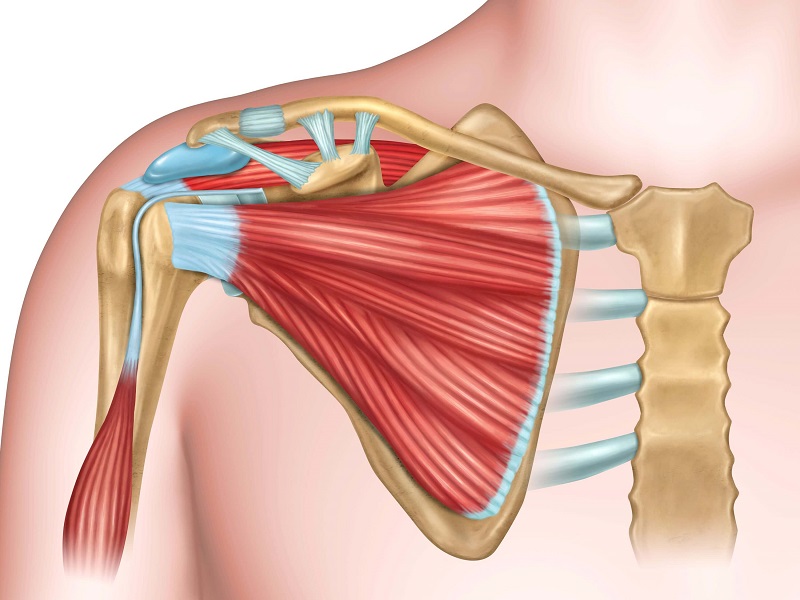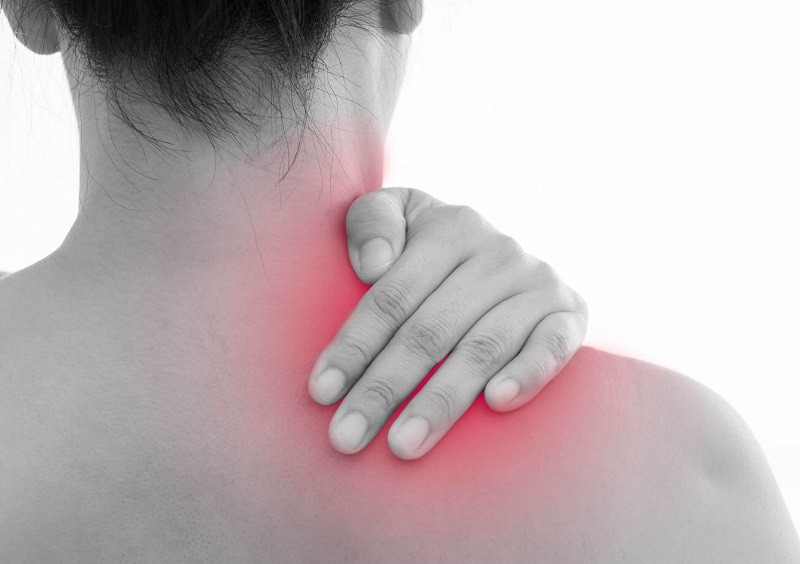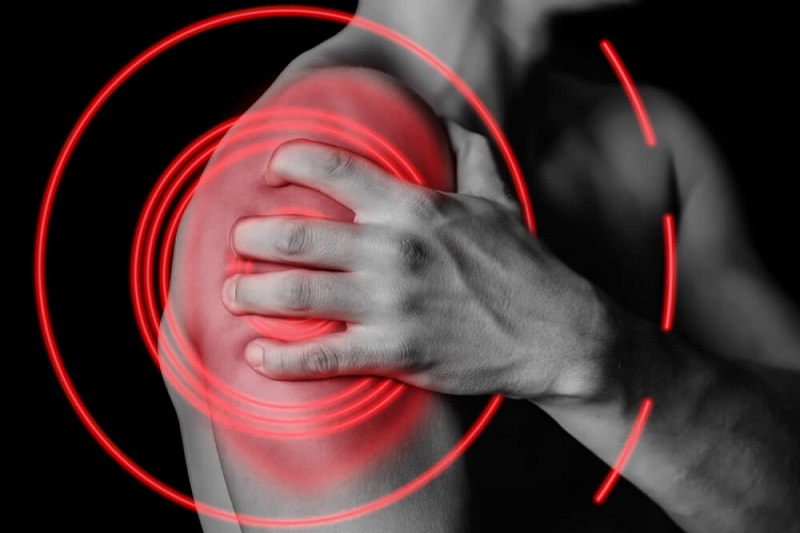Ligaments of the shoulder joints are a vulnerable place, especially during overuse activities such as playing sports, with dull pain symptoms that last, making the patient’s movement and activities restricted.
So when ligaments are damaged, how to handle them? In which case you should see a doctor for treatment is important information you can learn through this article.
Learn About Shoulder Ligaments
The structure of the shoulder joint includes the clavicle, the scapula, and the arm bone combined with the soft tissues in the shoulder to create a flexible shoulder joint.
At the intersection of the bones make up the arm drive joint and the collarbone, in which the task of keeping the joints is done by the shoulder ligament and sheath.
To allow the arm bone to hang into the socket – the right arm relies on the muscle tendons that surround the shoulder joint (also known as the rotating apex) and the ligament.

In fact, the ligamentous system of the shoulder joint (coracohumeral ligament) has only the ligament of the crew arm, which is located in the crest itself extending to the sheath. For the ligaments pans – arms (glenohumeral ligaments) are formed thanks to the thickening of the sheath.
Considered to be the most flexible joint in the body, shoulder ligaments allow the arm to move freely and gently, but this is also the reason why the shoulder blade is susceptible to soft tissue damage.
Causes that can lead to ligament rupture or shoulder injury can stem from:
• When performing large, sudden, or prolonged joint movements.
• Thin joint covering.
• Pan clutch – arm is unstable.
• Due to a loose ligament or a deficiency occurred.
• When the muscles around the shoulder joint are weakened.
Symptoms When Ligaments Are Problems
One of the injuries to the shoulder ligament is a rupture of the ligament. Usually, the most typical symptom of a shoulder ligament rupture is a severe pain sensation that comes suddenly. In addition, other symptoms may also develop including:

• In the affected shoulder area, a bruise appears.
• Swollen shoulder joints.
• Movement in the shoulder joint is difficult.
• After about 2-3 weeks without treatment, a ligament rupture may develop muscle atrophy around the shoulder.
In the case of a ligament rupture, which is common in athletes or people who work regularly, a strong force is applied to the shoulder ligament.
Another common shoulder ligament problem is ligament relaxation. Ligament or shoulder ligament stretches are often caused by joint tension beyond the permissible range during sudden activities, or when the patient is sitting in the wrong position for prolonged periods, or can also be caused by age problems that cause ligaments. stretched. Symptoms, in the early stage, if the shoulder ligament is stretched, there will be symptoms such as:
• The shoulder blade area, the back of the neck are swollen, red, and painful to the touch.
• Pains accompany a mild, sudden but sparse throbbing sensation and the pain subsides on its own over a period of time.
• Ligament stretching if not treated early will develop silently, easily causing dangerous complications.
• If the condition persists, the pain spreads to the arms and down the back, and pain is usually more constant and intense than before.
For shoulder ligament stretching, patients also have a feeling of fatigue, causing difficulty in mobility and easily dislocated shoulder joints.
Although this is a shoulder joint disease that is not too dangerous if rested, properly treated, it requires the patient’s patience to follow the treatment regimen, since the treatment of shoulder ligament relaxation is relatively complicated and prolonged.

A dislocated shoulder joint while sleeping is also not uncommon, with typical symptoms being dull or intense pain that lasts depending on the level of the shoulder and nape if the condition worsens it will cause dizziness, tinnitus, tired people … cause many people to worry whether it will pose a serious danger.
According to specialists, dislocations of the shoulder when sleeping is not a problem too serious can be resolved after a few weeks of non-surgical treatment.
However, it should not be too subjective, if the dislocated shoulder is not properly repaired, it can lead to a number of complications that damage the nerves, causing difficulty in movement and difficulty falling asleep. More danger could cause the arm to lose its sense of being unable to move.
What To Do When Shoulder Ligaments Pain?
How long does it take to stretch the shoulder ligaments? Or how long to stretch wrist ligaments is a common question of many people when ligaments in general.
Depending on the condition of the injury, the exact recovery time of the patient can be confirmed. In addition, the treatment process also depends on many factors such as:
• The severity of the injury, dislocation … in the shoulder ligament.
• Appropriate and effective treatment regimen.
• Coordination between doctor and patient, as well as a reasonable lifestyle change diet.
But the first factor patients need to remember is that when suffering a shoulder injury, there are symptoms of ligament rupture, ligament relaxation … with severe shoulder blade pain, you should not self-treat at home. go to the hospital for medical intervention, early treatment according to the disease status.
In the case of mild stretch ligaments, without feeling intense pain, the condition will gradually improve over time, patients need to rest, avoid vigorous exercise to quickly recover. But if the pain persists without any signs of remission or the pain appears with a high frequency, it is necessary to go to the hospital for the most accurate examination.
Diagnosis of Shoulder Ligament Injury
During the examination, the doctor will first exploit the information to have a basis for diagnosis, find the cause such as:
• When the patient started to experience pain, how long it lasted.
• A detailed description of the pain is needed to provide a further baseline for identification.
• History of previous pain, medical history.
• The treatment methods the patient has used in the past.
• Living habits after experiencing pain.
The assessment of the condition of the shoulder injury, helps the doctor find the cause, determine the severity to have the most appropriate treatment regimen. Often the methods of diagnosis used are:

• Observe and look for abnormal signs in the affected shoulder area such as redness, muscle weakness, deformity …
• Check to assess if the motion amplitude of the shoulder joint, tendon area, and shoulder muscle strength is problematic.
• X-ray, CT scan: Help the doctor see the most detailed image, detect the damage if any in the patient’s shoulder joint.
• Contrast x-ray: This is a method that can see the damage if there is a joint and have a clear view of the tendon structure around the affected area.
• MRI scan and ultrasound: Detect signs of shoulder ligament rupture, see detailed imaging in soft tissues and damage related to tendons and muscles covering the shoulder joint.
• Electromyography: This is a method to evaluate nerve function.
• Arthroscopy: Through arthroscopy will help doctors find out the exact cause of shoulder ligament pain and detect soft tissue-related damage.
How To Treat Damaged Shoulder Ligaments?
Drug treatment
When determining the cause of the shoulder ligament pain or injury, depending on the case, the doctor will have a specific treatment regimen. But normally, up to about 90% of shoulder blade pain cases can respond to the usual treatment regimen by using drugs.

Your doctor will prescribe a number of anti-inflammatories, anti-inflammatory drugs, and may also require an injection of anesthetics or corticosteroids in some cases to relieve the patient’s pain.
However, the use of drugs must follow the prescription of a doctor and when unusual problems occur, notice immediately to avoid overuse of pain relievers that can lead to undesirable side effects.
Surgery
When long-term physical therapy and medication are not highly effective, your doctor will consider ordering surgery in severe cases involving shoulder ligaments.
There are surgical methods commonly used are shoulder arthroscopic surgery to repair torn tissues, remove scar tissue, or open surgery to help restore damage as severe and widespread as when patient with a fracture, extensive tendon rupture, or in case of shoulder joint replacement.
During treatment, patients should also pay attention to avoid bad habits or improper self-treatment that will make the condition worse, such as:

• Manually manipulating the shoulder joint without the guidance of a specialist.
• Use some self-medicating oils or alcohol.
• Excessive immobility leads to a more serious condition.
• Ineffective physical therapy and movement exercise.
• The exercise is too much and does not pay attention to follow-up after treatment.
Thus, the shoulder ligament is a place that is susceptible to undesirable damage stemming from many reasons because of the rather specific function of this area. When symptoms related to shoulder ligaments such as severe pain, prolonged and limited movement, the patient should spend a lot of time resting, avoid vigorous exercise and it is best to go to the hospital to diagnose the most suitable treatment.
The site cannot and does not contain medical advice. The medical information is provided for general informational and educational purposes only and is not a substitute for professional advice. Accordingly, before taking any actions based upon such information, we encourage you to consult with the appropriate professionals.

 1900 1717
1900 1717 